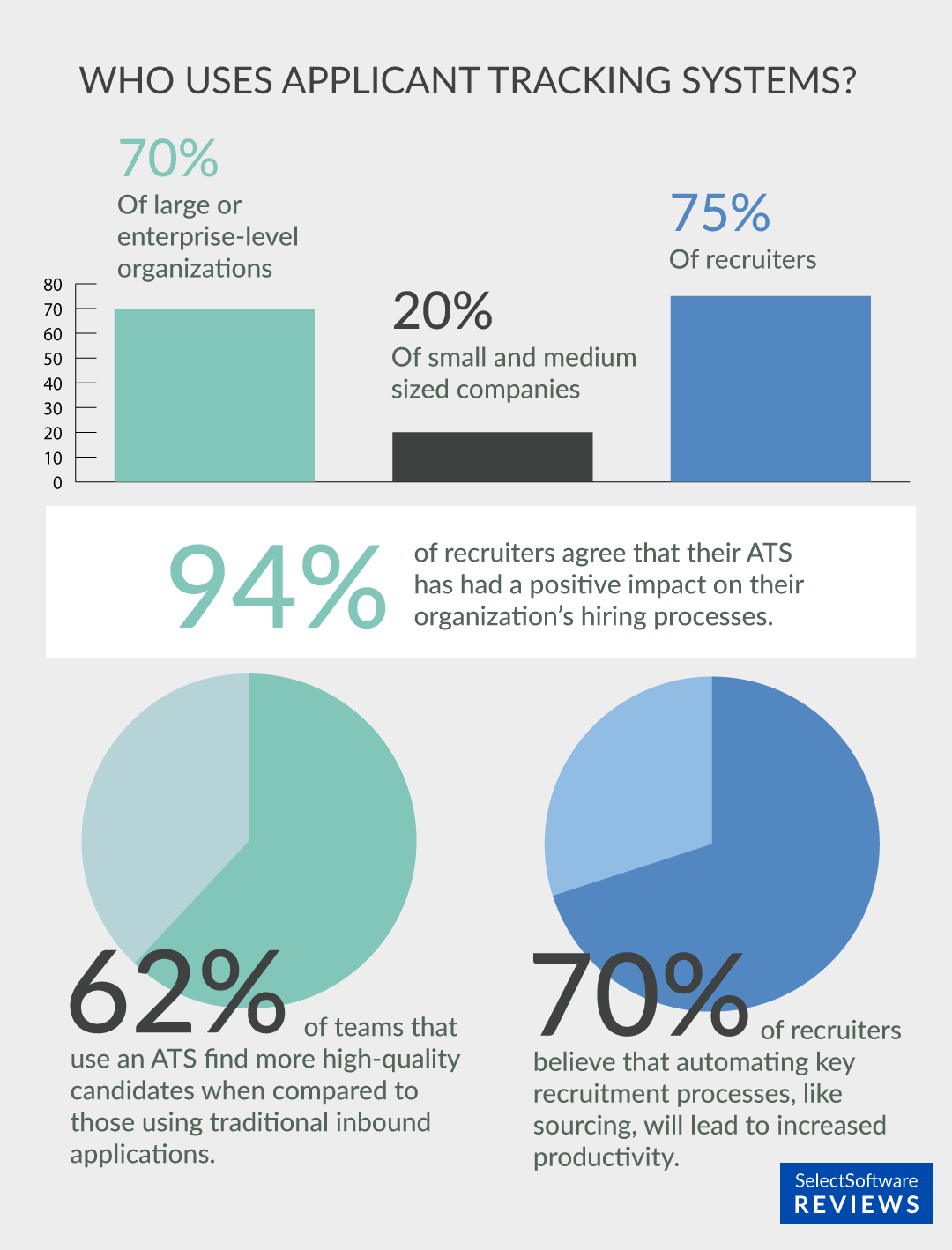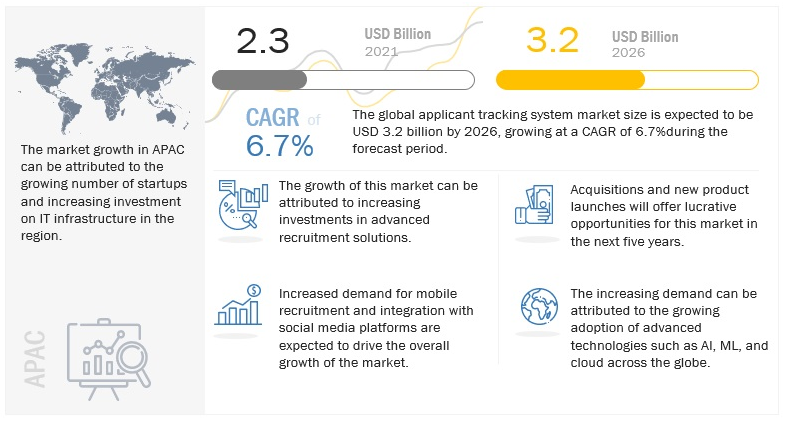Applicant tracking systems (ATS) are designed to streamline and optimize the hiring process and can eliminate the hassle of filling open roles while guiding candidates through their initial application. Generally speaking, ATS software is capable of automating processes, scheduling interviews, parsing resumes, and delivering documentation. Some can even perform native ATS background checks as necessary.
Looking for the best applicant tracking systems? Check out these platforms!
While most ATS platforms have their own features, nuances, and quirks, they all fulfill the general need of collecting applications and maintaining communications with prospective new employees.
But how well do modern ATS platforms perform in the real world? Do they live up to the expectations of hiring teams, or do they fall short? What exactly do the statistics say?
The ATS Market
According to recent studies, nearly 99% of all Fortune 500 companies use ATS platforms on a regular basis.
- 70% of large companies currently use an ATS.
- 20% of small and mid-sized businesses currently use an ATS.
- 75% of recruiters use an ATS or another tech-driven recruiting tool to review applicants and strengthen the overall candidate experience.
- 94% of recruiters agree that their ATS has had a positive impact on their organization’s hiring processes.

Organizations, staffing agencies, and recruiters aren’t the only ones affected by the proliferation of the modern ATS. Since employers in nearly every industry have already begun implementing ATS platforms, job seekers have had to adapt, too.
- 73% of current job seekers are considered passive, but an ATS can help increase engagement and strengthen communications.
- It can cost up to nine months' salary to replace an employee, but most ATS platforms will help you detect potential attrition problems well in advance.
- Top candidates are only on the market for an average of 10 days, but an ATS can help grab their attention and get the ball rolling.
- 88% of employers believe they are losing out on highly qualified candidates who are screened out of hiring processes by ATSs because they aren’t submitting ‘ATS-friendly’ resumes (i.e., including criteria or keywords that the ATS is programmed to look for).
- More than 9 in 10 job seekers (92%) never complete their applications.
For teams that would rather stick to their traditional business processes, embracing the myriad benefits of an ATS that can be realized is difficult. In cases like this, it’s best to examine the overall impact an ATS has on the actual recruitment process.
ATS Impact on the Recruitment Process
The right ATS features will help you create new job postings for online job boards, attract top talent in your industry, and extend job offers to qualified candidates. But how does this software impact your overall recruitment process?
- Recent studies indicate that an effective ATS can decrease the average hiring cycle by as much as 60%.
- 62% of teams that use an ATS find more high-quality candidates when compared to those using traditional inbound applications.
- 70% of respondents believe that automating key recruitment processes, like sourcing, will lead to increased productivity.
- 68% of recruiters want to invest in newer recruiting technology, like next-gen ATS platforms, as a means of increasing day-to-day performance.
- More than 86% of recruiters agree that their ATS has reduced their overall time-to-hire.
- 79% of recruiters agree that the quality of their new hires has increased after implementing an ATS.
- The average online job posting results in 250+ candidates, but only four to six of them will be invited to a formal interview.
For many organizations, an ATS lets them bridge the gaps between their traditional hiring processes and those that are rooted in the digital age. But how are ATS integrations helping them leverage other forms of next-gen technology?
ATS Integration & Technology
Modern technology has changed the hiring process in many different ways. Not only do job seekers find and browse job openings in entirely new ways, but hiring teams have achieved greater levels of process optimization and efficiency than ever before.
In many cases, much of this credit falls squarely on the company’s ATS.
- Using AI technology could help save HRs by screening unqualified candidates, which often make up about 88% of applicants. Additionally, early adopter companies implementing AI sourcing tools are seeing a 75% reduction in cost per screen.
- McKinsey predicts that generative AI has the potential to boost labor productivity by 0.1 to 0.6 percent each year until 2040, dependent on the rate of technology adoption and the reallocation of worker time to alternative activities.
- Over half of those surveyed adopted AI technology in some capacity in their organization, and about the same figure who implemented it within their talent management saw reduced costs.
- 65% of HR leaders view AI positively, and AI is primarily used in recruiting (43%).
- AI is seen positively by 65% of HR leaders, with its primary application in recruiting (43%).
- 79% of organizations have integrated AI or automation directly into their ATS.
- 64% of survey respondents use AI or automation to filter out unqualified candidates.
Again, integrating ATS with other recruiting software affects job seekers, too. While many actively use the technology they have at their disposal, they’re quite discerning when it comes to finding and applying for jobs via the Internet.
- Social media is crucial for hiring and employer branding, with 98% of companies using it. LinkedIn (78%) and Facebook (65%) are the top platforms, while Instagram (58%) gains traction for younger job seekers. Videos are the most popular post format, while "life at the company" posts are declining.
- According to Yello’s 2024 State of Campus Recruiting report, 68% of Gen Z said they job search on LinkedIn, followed by Indeed at 51% and WayUp at 39%.
- While the majority of candidates (31%) initiate their job search through job boards, more than half (57%) prefer to locate a position on the company's website and apply directly.
- 69% of Gen Z job seekers use their smartphones to find new job opportunities.
- When using an ATS, the turnover rate of new hires is an average of 40% less than that of those without.
- 69% of applicants won’t accept a job offer if the company takes too long to respond.
Location plays the biggest role in influencing whether a candidate will apply or accept an offer, chosen as an important factor when considering where to apply or which offer to accept by more than 80% of respondents in the cited Yello survey. When asked “Do you prefer working in an office, hybrid, or fully remote?”, 50% preferred a hybrid option, followed by fully remote (31%) and fully in-office.
For that reason, not only do most ATS platforms support remote and hybrid workers, but some of them are made specifically with these workers in mind.
- 12.7% of full-time employees currently work from home.
- 28.2% of full-time employees split time between home and the office in a hybrid work model.
- 93% of employers that conduct remote interviews plan to continue doing so in the future.
- 98% of all current workers would prefer to work remotely some of the time.
- 68% of remote workers have had a positive experience when away from the office.
- 98% of remote workers would recommend remote work to others.
- 82% of those who work remotely are actively working from the comfort of their own home.
- 64% of current remote workers are considered fully remote, while 18% are in hybrid or remote-first roles.
By complementing traditional hiring processes with digital recordkeeping, automated compliance, and AI-driven recruitment, organizations can move away from such menial tasks and switch their focus to onboarding, training, and ongoing employee satisfaction for hybrid, remote, and on-site teams.
Future ATS Trends
Today, ATS systems are still a relatively new innovation. Not only are hiring teams, recruiters, and job seekers still learning how to use these platforms, but the software itself has yet to realize its full potential. As a result, experts have a favorable view of the future of ATS software.
- Recent reports suggest that the global ATS market will be worth $4.88 billion by 2030.
- 25% of organizations are planning to implement an AI-driven ATS by 2027.

Some Final Thoughts on These Applicant Tracking Statistics
All signs point to ATS platforms becoming a mainstay in the future of recruitment and hiring. The statistics above point to the efficiency and effectiveness of these platforms in optimizing hiring efforts.
In the age of automation and other forms of AI, the repetitive tasks that can be performed by an ATS will only increase, freeing up more time for HR and recruitment professionals to add strategic value to their organizations.
Applicant Tracking System Statistics: Sources
Zippia, The Undercover Recruiter, SHRM, LinkedIn, Man Power Group, McKinsey, Yello, WorkforceHub, WFH Research, Buffer, MarketsandMarkets.




























